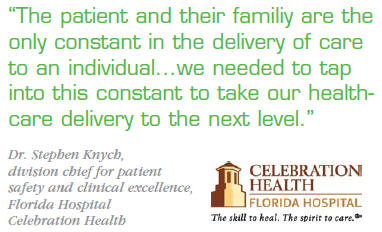The Secrets Of Successful Patient Engagement

By Ken Congdon, Editor In Chief, Health IT Outcomes
Florida Hospital Celebration Health credits the right mix of process change and technology for a patient engagement effort that has resulted in improved staff communication and patient pain control.

Patient engagement is at the core of many of the Stage 2 Meaningful Use criteria, and for good reason. Multiple studies illustrate the monumental impact properly engaged patients have on their own outcomes and the overall cost of care. For example, through provider coordination and ongoing patient engagement and monitoring, the VA’s Coordinated Care and HomeTelehealth program was able to achieve the following results for its patients with chronic diseases:
- 19.74% reduction in hospital admissions
- 25.31% reduction in bed days of care
- A $1,600 average annual cost per patient versus a $13,121 annual cost per primary care patient not enrolled in the program
- A 20% to 57% reduction in the need for patients to be treated for chronic diseases such as diabetes, COPD, heart failure, and depression.
The benefits of patient engagement are unquestionable. However, many health providers are concerned about their ability to achieve patient cooperation. The question many of them ask is, “How do I force my patients to take an interest and be an active participant in their own health?” Indeed, there is no easy answer to this question, but Florida Hospital Celebration Health, a 174-bed hospital that is part of the Adventist Health System, has concocted a patient engagement formula that is proving effective.
THE PATIENT IS THE ONLY CONSTANT IN CARE DELIVERY
Florida Hospital Celebration Health began its patient engagement journey 18 months ago. “The primary motivation for our patient engagement initiative was the realization that the patient and their family are the only constant in the delivery of care to an individual,” says Dr. Stephen Knych, division chief for patient safety and clinical excellence at Florida Hospital Celebration Health. “Physicians, nurses, technicians, and other providers all come and go. We realized we needed to tap into this constant to take our healthcare delivery to the next level. Our focus quickly shifted from why we should do this to how, and that’s where our journey really began.”
Florida Hospital Celebration Health was introduced to GetWellNetwork, a provider of patient engagement solutions, through one of its sister hospitals and decided to implement the company’s Interactive Patient Care (IPC) technology in its facility. IPC provides educational and entertainment resources to the patient at the bedside through an in-room TV. This approach is supported by interactive services that are designed to meet each patient’s individualized needs and provide hospital staff with the tools to deliver patient education, pain management, and medication information. The solution integrates with traditional EHR and hospital IT systems including Cerner, McKesson, and GE Healthcare.
HOSPITAL MINDSET MUST CHANGE FIRST
While impressed by the technology, Florida Hospital Celebration Health quickly realized that simply installing the IPC solution wouldn’t magically deliver the patient engagement results it desired. “The IPC technology we invested in is definitely cool, but it would be little more than an interactive TV unless we did our due diligence to change the mindset of our staff,” says Dr. Knych. “We needed to get our nurses and physicians invested in this project for the system to perform as envisioned. They needed to believe in the initiative. This required a little strategy and some process redesign.”
First, Florida Hospital Celebration Health ensured that its lead, middle management, and frontline clinicians were all involved in the content development for the IPC system. Clinicians customized the content for each of their specific specialties. This practice promoted employee buyin because each clinician felt the content he or she selected for the program was important for their patients to learn.

Next, Florida Hospital Celebration Health began a five-month nursing process redesign to prompt and encourage more patient interaction. One of the first processes it tweaked was its nursing change-of-shift reports. Historically, when a nurse’s shift ended, that nurse would download one-on-one with her replacement about the course of patient care. As part of the patient engagement initiative, these interactions were moved to the patient’s bedside. Transferring this information in the patient’s presence accomplished a couple key objectives. First, it simply made the patient aware that a new nurse will be responsible for his or her care. Second, it allowed the patient to be an active participant in the exchange of information to the new nurse. For example, the patient could chime in and inquire or confirm when they are scheduled to have specific tests run.
TECHNOLOGY SUPPORTS PATIENT ENGAGEMENT
Once the cultural mindset and processes were in place to promote patient engagement, Florida Hospital Celebration Health began leveraging features of the IPC technology to support the initiative. For example, the IPC solution includes a “care path” toolset that provides clinicians with a clear outline as to what educational content to share with each individual patient and when. These care paths are focused on effectively managing chronic diseases by encouraging patient engagement throughout their hospital stay.
First, the care path helps the clinician determine how engaged the patient is likely to be. In other words, is the patient a passive couch potato or an active participant? Based on where the patient falls on this scale, a custom education pathway is then generated that prompts the clinician to present the patient with different pieces of educational content related to their condition and care systematically from admission through discharge. For example, a clinician may be asked to repeat steps for an “unengaged” patient to ensure they comprehend the content and next actions.
“Historically, patients have been bombarded with all of their educational information and follow-up instructions at the time of discharge,” says Dr. Knych. “Our focus group research shows us that patients and their families have difficulty digesting all of this information at once. The care paths provided as part of the IPC solution prompt us to feed this information to our patients in bite-sized chunks in a programmed way, which helps with retention.”
The IPC solution has also helped support Florida Hospital Celebration Health’s patient engagement efforts in a more basic, but equally as important, way. “Our nurses have always desired an effective way to address patient questions at the exact time they are asked,” says Dr. Knych. “In the past, they lacked confidence in this area. They often had to do some research or confer with a physician before being able to answer a patient’s inquiry. Using the ‘direct care’ button as part of the IPC solution, our nurses now have access to patient information and educational content that allow them to confidently address patient questions immediately.”
ACTIVE RATHER THAN PASSIVE COMMUNICATION IS KEY
Throughout the course of its patient engagement journey, Florida Hospital Celebration Health has identified a few key best practices that have been instrumental in its success. The first is the importance of active, rather than passive communication.
“Traditionally, we would provide our patients with a printed brochure upon discharge that outlined how we expected them to be involved in their care,” says Dr. Knych. “Our focus groups told us patients rarely read these brochures. If you want a patient to be engaged, you need to actively solicit their participation. You need to ask them for their input and feedback, and repetition is key. If you ask the patient for their feedback once, they usually won’t give it to you. They’ll just think you’re being nice. But ask them two, three, and four times, and they start to act upon it. They become an active participant in their care.”
Another best practice Florida Hospital Celebration Health identified was to actively ask patients about areas related to its ultimate HCAHPS (Hospital Consumer Assessment of Healthcare Providers and Systems) survey scores while they are in the hospital. Furthermore, provide these patients with immediate access to the staff members who can have an immediate impact in these areas.
“Asking for continual patient feedback during their stay gives you the opportunity to immediately address issues and improve the perception the patient has of your hospital,” says Dr. Knych. “Even if it’s something as basic as room temperature or their meals, solicit patient feedback, and give them access to the engineers or nutritionists that can immediately improve the patient experience. It makes you incredibly agile.”
The patient engagement best practices and technologies deployed by Florida Hospital Celebration Health have had a dramatic impact on the hospital’s performance. To date, the hospital has seen an 11.4% improvement in nurse communication, a 5.3% improvement in staff responsiveness, a 10.6% improvement in patient pain control, and a 24.6% improvement in room cleanliness. Furthermore, Celebration Health is the highest scoring Florida Hospital campus in regards to overall patient satisfaction and willingness to recommend.
“There’s a perception among some healthcare providers that patients don’t want to be involved in their care,” says Dr. Knych. “I don’t believe that. I believe that 85% to 95% of patients truly want to be active participants in their ongoing care. Much like providers, patients need to be reprogrammed to change their habits. They need to be given cues as to what is expected of them. The key for providers is to provide patients with the right information at the right time so that they will innately start doing what you want them to do.”
